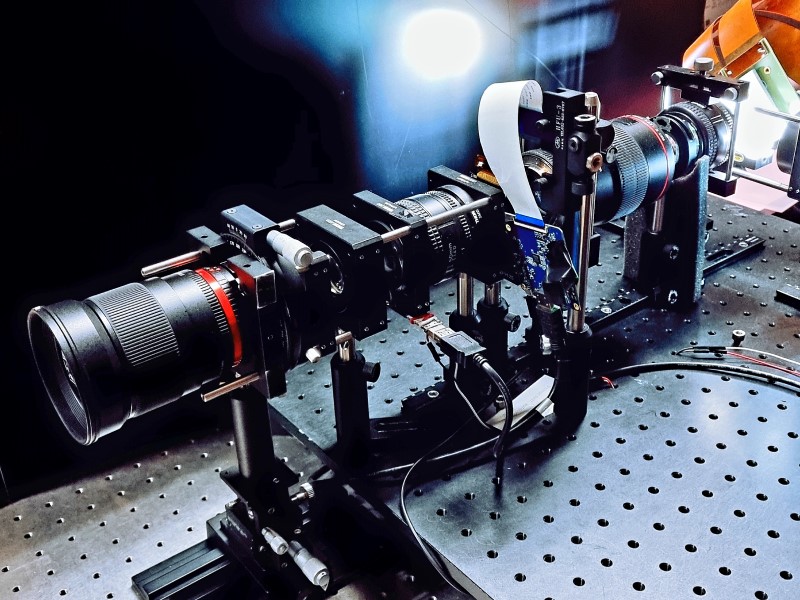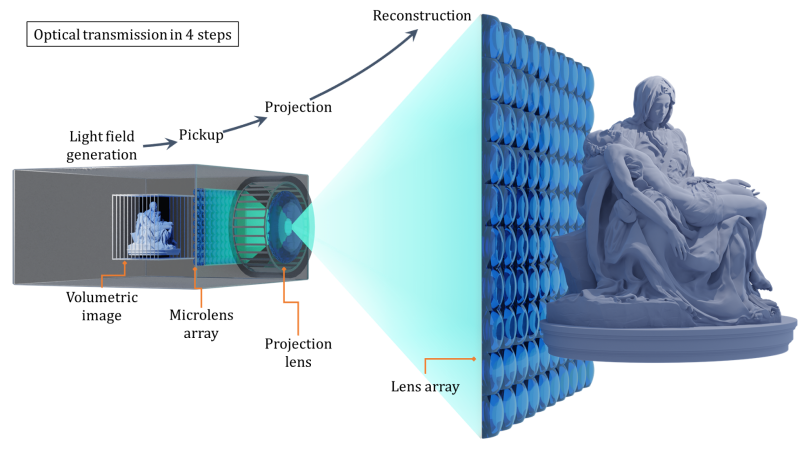About
24 August 2021
New Technology Lays Groundwork for Large-Scale, High-Resolution 3D Displays
Projection approach could enable large, high-definition 3D images for digital signs and immersive experiences
WASHINGTON — Researchers have developed a prototype display that uses projection to create large-scale 3D images with ultra-high definition. The new approach helps overcome the limitations of light-field projection, which can create natural-looking 3D images that don’t require special 3D glasses for viewing.

Caption: Researchers combined two different light field display technologies to project large-scale 3D images with almost diffraction-limited resolution. Their optical setup is shown.
Credit: Byoungho Lee, Seoul National University
“Our optical design could make it practical to replace 2D flat panel displays with 3D images for digital signs, entertainment, education and other applications where 3D images provide a significant enhancement,” said research team leader Byoungho Lee from Seoul National University in Korea. “Our design could also be modified to provide immersive experiences in movie theaters, for example.”
In The Optical Society (OSA) journal Optics Letters, the researchers describe how they combine two different light-field display technologies to project large-scale 3D images with almost diffraction-limited resolution. The new display is autostereoscopic, which means that it produces different 3D images so that the image can be viewed from various angles.
“We developed a way to carry out all the display processes optically without any digital processing,” said Lee. “This compensates for the limitations of each display technology to allow the creation of high-resolution 3D images on a large screen.”
Combining technologies
Light-field displays work by reproducing light that is reflected from an object in a way that corresponds to the actual visible position. Because autostereoscopic light field displays produce different images for different viewing angles, they require a huge amount of information to be processed. This demand creates a tradeoff between resolution and the size of the displayed image because the hardware of the display gets overwhelmed by the amount of information required.

Caption: The new display optically transforms the object display volume generated from the multifocal display into the projection volume for integral imaging by automatically mapping the rays through a microlens array (optical pickup). The transformed information can be enlarged to the large screen through a projection lens. After the projection, the object display volume is reconstructed, passing through another lens array in a similar manner to the existing integral imaging system.
Credit: Byoungho Lee, Seoul National University
To overcome this limitation, the researchers designed a new optical configuration that combines a multifocal display with integral imaging. Typically, a multifocal display can generate a high-quality volumetric image, but it is technically difficult to implement on a large-screen system. On the other hand, integral imaging is better at enlarging images.
In the new design, the multifocal display generates a high-resolution 3D, or volumetric, scene while the integral imaging technology enlarges it for viewing on a large screen. The information conversion between the multifocal display and integral imaging is all performed optically without any digital processing.
“Our method goes beyond merely combining two existing methods to achieving an ultrahigh-definition volumetric light-field display with almost diffraction-limited resolution,” said Lee. “We also found a way to effectively resolve the difficulty of enlarging a volumetric scene and overcame problems with information loss that tend to affect integral imaging.”
Large and high-resolution 3D images
After verifying the resolution of their prototype system, the researchers qualitatively confirmed that a volumetric image was reconstructed. The tests showed that the prototype can synthesize a volumetric image of 21.4 cm x 21.4 cm x 32 cm, which is equivalent to 28.6 megapixels and 36 times higher resolution than the original image.
“Our approach is very efficient at processing information, which enables a low computing cost as well as simple, high-quality, real-time system configuration,” said Lee. “The optical design can also be seamlessly integrated with various techniques used in existing light-field displays.”
The researchers are now working to optimize the optics and further reduce the complexity of the multifocal display to make the projector more compact. They note that because the system is a fusion of two different technologies, the performance of their proposed system will likely improve as each technology develops.
Paper: Y. Jo, K. Bang, D. Yoo, B. Lee, “Ultrahigh-definition volumetric light field projection,” Opt. Lett., 46, 17, 4212-4215 (2021).
DOI: https://doi.org/10.1364/OL.431156.
About Optica Publishing Group
Optica Publishing Group is a division of the society, Optica, Advancing Optics and Photonics Worldwide. It publishes the largest collection of peer-reviewed and most-cited content in optics and photonics, including 18 prestigious journals, the society’s flagship member magazine, and papers and videos from more than 835 conferences. With over 400,000 journal articles, conference papers and videos to search, discover and access, our publications portfolio represents the full range of research in the field from around the globe.
About Optics Letters
Optics Letters has been publishing high-impact research in the field of photonics for over 45 years and offers rapid dissemination of new results in all areas of optical science with short, original, peer-reviewed communications. Optics Letters accepts papers that are noteworthy to a substantial part of the optics community. Published by Optica Publishing Group and led by Editor-in-Chief Miguel Alonso, Institut Fresnel, École Centrale de Marseille and Aix-Marseille Université, France, University of Rochester, USA. For more information, visit Optics Letters.
About Optics Letters
Optics Letters has been publishing high-impact research in the field of photonics for over 45 years and offers rapid dissemination of new results in all areas of optical science with short, original, peer-reviewed communications. Optics Letters accepts papers that are noteworthy to a substantial part of the optics community. Published by Optica Publishing Group and led by Editor-in-Chief Miguel Alonso, Institut Fresnel, École Centrale de Marseille and Aix-Marseille Université, France, University of Rochester, USA. For more information, visit Optics Letters.
Media Contact
